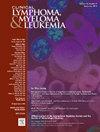Real World Data on Efficacy and Safety of EPOCH in T-Cell Lymphoma
IF 2.7
4区 医学
Q2 HEMATOLOGY
引用次数: 0
Abstract
Background
T-cell lymphomas are a heterogeneous group of lymphoid malignancies with poor outcomes. Frontline multiagent chemotherapy options include CHOP (prednisone, vincristine, cyclophosphamide, and doxorubicin), brentuximab-CHP, CHOEP, and EPOCH (etoposide, prednisone, vincristine, cyclophosphamide, and doxorubicin).
Patients and Methods
We report our single institution data for safety and efficacy of EPOCH in 38 patients with aggressive T-cell lymphoma including both peripheral T cell lymphoma (PTCL) and cutaneous T-cell lymphoma (CTCL).
Results
Eighteen patients received EPOCH as first-line and 21 in the relapsed/refractory (R/R) setting. In 36 evaluable patients, the overall response rate (ORR) was 77% (95% CI, 61%-89%) with 19 (53%) patients achieving complete response (CR) (95% CI, 36%-69%). The ORR in first line and R/R settings were 80% (95% CI, 46%-94%) and 75% (95% CI, 52%-90%), respectively. Response rate was similar in African American versus Caucasian patients but was higher in CD30 negative versus positive patients. Most common grade 3/4 adverse events included cytopenias.
Conclusions
Overall, EPOCH was well tolerated with high response rates in first line and R/R setting.
关于 EPOCH 在 T 细胞淋巴瘤中疗效和安全性的真实世界数据。
背景:T细胞淋巴瘤是一类异质性淋巴恶性肿瘤,治疗效果不佳。一线多药化疗方案包括CHOP(泼尼松、长春新碱、环磷酰胺和多柔比星)、布伦妥昔单抗-CHP、CHOEP和EPOCH(依托泊苷、泼尼松、长春新碱、环磷酰胺和多柔比星):我们报告了单个机构对38例侵袭性T细胞淋巴瘤(包括外周T细胞淋巴瘤(PTCL)和皮肤T细胞淋巴瘤(CTCL))患者使用EPOCH的安全性和有效性数据:18名患者接受了EPOCH一线治疗,21名患者接受了复发/难治(R/R)治疗。在36例可评估的患者中,总反应率(ORR)为77%(95% CI,61%-89%),其中19例(53%)患者获得完全反应(CR)(95% CI,36%-69%)。一线治疗和R/R治疗的ORR分别为80%(95% CI,46%-94%)和75%(95% CI,52%-90%)。非裔美国人与白种人患者的应答率相似,但CD30阴性与阳性患者的应答率更高。最常见的3/4级不良反应包括细胞减少症:总体而言,EPOCH耐受性良好,在一线和R/R治疗中反应率较高。
本文章由计算机程序翻译,如有差异,请以英文原文为准。
求助全文
约1分钟内获得全文
求助全文
来源期刊

Clinical Lymphoma, Myeloma & Leukemia
ONCOLOGY-HEMATOLOGY
CiteScore
2.70
自引率
3.70%
发文量
1606
审稿时长
26 days
期刊介绍:
Clinical Lymphoma, Myeloma & Leukemia is a peer-reviewed monthly journal that publishes original articles describing various aspects of clinical and translational research of lymphoma, myeloma and leukemia. Clinical Lymphoma, Myeloma & Leukemia is devoted to articles on detection, diagnosis, prevention, and treatment of lymphoma, myeloma, leukemia and related disorders including macroglobulinemia, amyloidosis, and plasma-cell dyscrasias. The main emphasis is on recent scientific developments in all areas related to lymphoma, myeloma and leukemia. Specific areas of interest include clinical research and mechanistic approaches; drug sensitivity and resistance; gene and antisense therapy; pathology, markers, and prognostic indicators; chemoprevention strategies; multimodality therapy; and integration of various approaches.
 求助内容:
求助内容: 应助结果提醒方式:
应助结果提醒方式:


